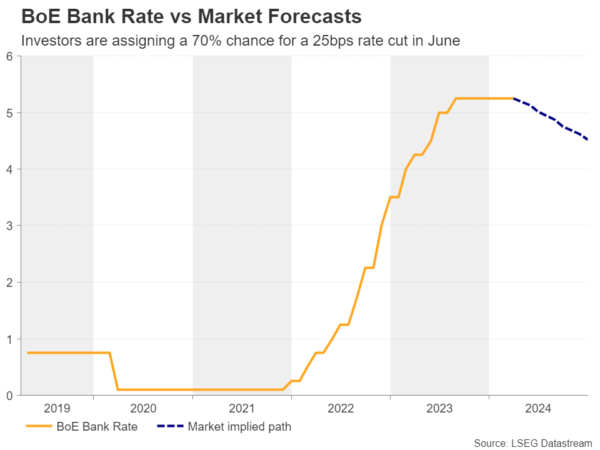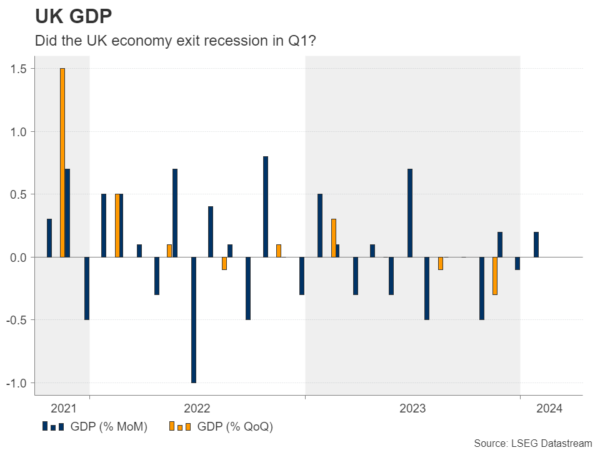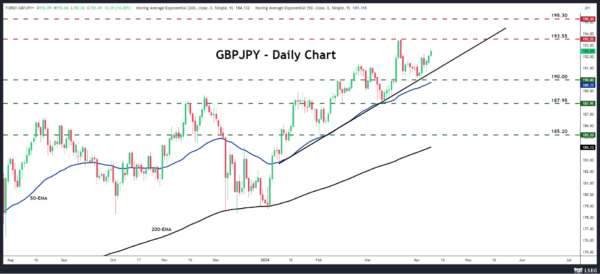- Dovish BoE encourages more rate cut bets
- UK GDP for February expected to reveal slowdown
- The data comes out on Friday at 06:00 GMT
Investors add to June rate cut bets after BoE decision
With inflation in the UK coming down faster than previously expected, the Bank of England (BoE) appeared more dovish than expected at its latest gathering, on March 21. Once again, officials kept interest rates unchanged, but this time, there were no members voting for a hike. There was only one dissenting vote, and that was for a 25bps reduction.
On top of that, Governor Bailey reiterated that they are not yet at the point where they can cut interest rates, but he added that with inflation coming down, things are moving in the right direction.
This has led market participants to bring forward their BoE rate cut bets, with the overnight index swaps (OIS) market suggesting a 25% probability for a quarter point reduction at the Bank’s upcoming gathering in May, and chance for a cut in June rising to around 70%. The quick repricing has been weighing on the pound, with Cable tumbling from 1.2800 to near the 1.2600 area.
Did the UK economy exit recession in Q1?
For pound traders, this week may not be as busy as for dollar and euro traders, but they will still have the opportunity to reassess their view with regards to the BoE’s future course of action on Friday when the monthly GDP estimate for February is coming out, alongside the industrial and manufacturing production figures for the month.
Given that the UK economy slipped into recession in the second half of 2024, market participants may be eager to find out whether it entered growth mode again during the first quarter of the new year. The monthly GDP rate for January clocked in at 0.2% m/m, while the composite PMIs for both January and February pointed to improvement, although the March print pointed to a mild slowdown.
The aforementioned numbers suggest that the UK economy started the new year on a stronger footing, but that remains to be confirmed by Friday’s numbers. The forecast points to a slowdown to 0.1% m/m, which could revive some concerns regarding the performance of the UK economy, despite not entering contraction territory.
The NIESR GDP tracker points to a 0.3% q/q for the first quarter of 2024, but a soft monthly rate for February could bring that forecast into question, especially after the March PMIs pointed to a slowdown in business activity during the last month of the quarter.
Too early for conclusions as CPI data loom next week
Therefore, investors may remain convinced that there is a strong chance for the BoE to begin cutting interest rates in June, which could weigh somewhat on the pound. However, calling for a bearish outlook may still be premature, especially ahead of next week’s CPI data for March.
Despite the slowdown, the March PMIs also revealed that output prices across the UK private sector rose at the fastest pace in eight months, which tilts the risks surrounding next week’s inflation data to the upside. Therefore, even if the pound slips somewhat this week, it could bounce back up next week.
Pound/yen remains in uptrend mode
Pound/yen has been marching north since April 2, when it hit support at the crossroads of the 190.00 barrier and the short-term upward sloping support line drawn from the low of January 9. Even if the pair pulls back this week, as long as the retreat stays in check above 190.00, the bulls could remain willing to jump back into the action and aim for the high of March 20 at around 193.55.
On the downside, a slide below 190.00 could signal a larger bearish correction, but for a major trend reversal to start being examined, the pair may need to fall all the way below the 187.95 zone.
















